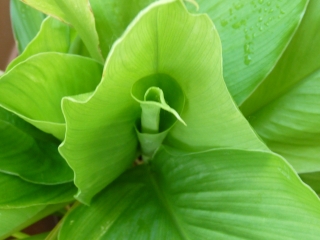home |
avr microcontroller & DIY electronics |
toolbox |
science club |
tuxtalk |
photos |
e-cards |
Online-Shop

no preservatives added blog |
computer and graphics corner |
herbal treasure chest |
splash into math |
stardust |
periodic table
turmeric

how to grow:
Turmeric is grown from roots. You put them into the soil in spring and then you wait and wait and wait some more. And when you think, well, it's a pity but it didn't work out, continue watering your pot because with a bit of luck eventually a plant will start to grow after all. I am not quite sure but it seems to me that the bigger the root the faster the plant will push out of the ground. I grow turmeric in a big pot so that I can take it inside in winter. It's a tropical plant so it wouldn't survive the harsh winters outside here in Montreal. However I have heard that people in warmer places like England can grow it in their garden all year.
At the beginning of the winter the plant is still full of beautiful green leaves. But eventually the leaves will become brown and fall off. Then the roots are ready to be used. You can cut one big root into smaller ones and use some as a powder in food and the other roots to plant new turmeric. Just put the root back in a pot with new soil and it will give you a nice plant again. Turmeric is a perennial so you could also leave it in the soil and it would grow back in spring all by itself if your climate is mild enough.
medicinal properties
Turmeric is native to India and South Asia and not just a staple in classic Indian and Asian dishes but also used in ayurvedic and traditional Chinese medicine for a long time. Already Marco Polo knew turmeric and mentioned it in this notebook.
Turmeric really is a cure all. Reading the entry about turmeric in Bharat B. Aggrarwal's book "Healing spices" really makes me want to eat turmeric in big quantities every day of my life as it is so good for being and remaining healthy. Turmeric is known to be a big cancer fighter. Studies have shown that taking the root or rhizome which contains curcuma as one of its big compounds together with black pepper increases the cancer fighting effects.
But it not only fights cancer but is also good for all kind of other diseases. It can help lowering blood cholosterol and prevent blood clots from forming that could be the cause of a stroke. It is used for liver disorders, skin infection, menstrual condition, digestive disorders, joint pain, heart disease and type 2 diabetes. Curcumin is an ingredient of Tylenol which means it can relieve headaches. Some nasal sprays contain curcumin so it can clear your nose when you have a cold. As a topical paste it is used for skin problems and as a powder to speed wound healing.
It may even protect against Alzheimer's disease as curcumin stops the accumulation of plaque in the brain.
cautions and possible side effects
Normal doses found in food are safe during pregnancy and breastfeeding but higher doses are said to may cause uterine bleeding or contractions.
Like with every food there are people who are allergic to it.
further reading
Healing Spices by Bharat B. Aggrawal p. 24ff
Rosemary Galdstar's Medicinal Herbs - a beginner's guide p.94-96
The Green Pharmacy Herbal Handbook by James A. Duke p. 215/216
National Geographics guide to medicinal herbs, p. 182-185
Copyright © 2004-2025 Katja Socher, tuxgraphics.org


